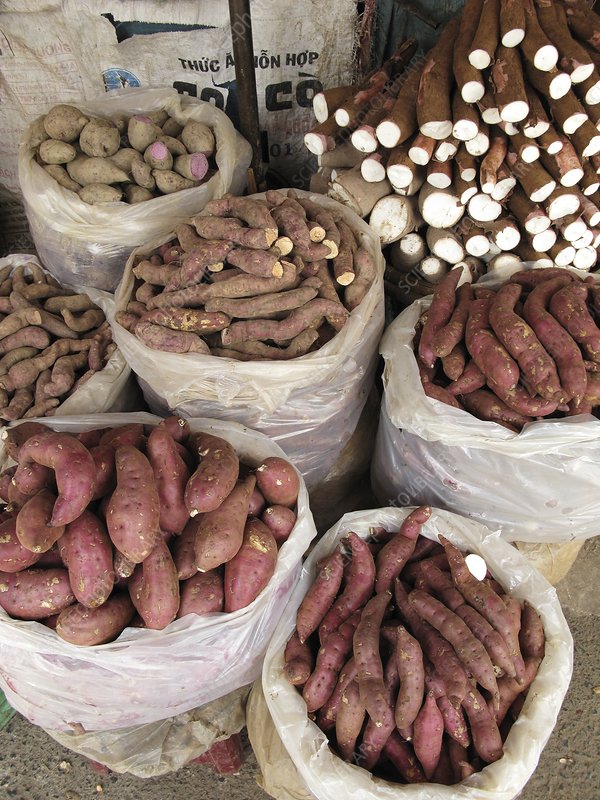
Sweet potato (Ipomoea batatas, front bags) and cassava roots (Manihot esculenta, rear bags). Sweet potatoes are sweet tropical root vegetables originating from Central America. Cassava roots are a staple part of the diet in many tropical countries, where they are eaten as a vegetable. Photographed at a market in Dalat, Vietnam.
…Releases two varieties of yam, potato.
Udoka Agwu, Umuahia.
In its effort to assist the Federal to boost Food Security in the country, the National Root Crops Research Institute,(NRCRI) Umudike has recorded major research breakthroughs on genetic improvement of root and tuber crops.
Such crops include: cassava, yam, potato and sweet potato among others.
Chiedozie N Egesi, (professor) the Executive Director/CEO of the Institute made the revealation on the occasion of his one year anniversary in office.
Egesi while addressing the Staff of the Institute during the occasion said the Institute started in 1923 as a Provincial Research Station noting that since then it had passed through so many transformations that had made the Institute to be one of the foremost Research Institutes in the Country.
He disclosed that the Institute had also carried out successful research into the entire farming system of the South East agro ecological zone,which had improved the standard of the smallholder farmers.
The Executive Director hinted that with the their partners, they developed and released two varieties of yam and four new varieties of potato that have excellent eating qualities, climate-resilient and very high in productivity for production by farmers.
“The potato industry in Nigeria and West Africa are set for a major change as these varieties will lead to increased annual productivity of the crop in Nigeria”said Egesi.
He further disclosed that his Administration was able to play a leading role that attracted about 10 new externally funded grants to the Institute, a feat which he noted was achieved in the first six months of his administration.
“We were able to also release in timely manner, funds for research Scientists to conduct their experiments and research activities. It is worth noting that every scientist whose proposal was duly evaluated and approved by Institute’s Proposal Committee, got funds to kick-start research work” enthused Egesi.
The Executive Director hinted that within his one year in office, the jinx of recruitment of Research Scientists from various Agricultural discipline for over 10 years had been broken as efforts are in top gear to replace junior staff who have left or retired from the Institute.
The Chief Executive said his administration has made efforts to support the Institute’s six out stations that have been facing long-term decaying infrastructure, for the first time in five years.
“Having in mind that the Institute needed rebranding, my leadership internationally rebranded the Institute’s image and perception which has been showcased effectively on our social media platforms. We designed a new Logo that better tells the story of our mandate and work. This has secured a brand and renewed interest towards the Institute “said the ED.
Egesi further informed that some old buildings were retrofitted for modern purposes while a new office block for the planning, monitoring & Evaluation department was built and commissioned in September.
He also said that in addition a new biotechnology complex is on going in Kuru, Plateau State, one of the the Institute’s out stations while some other projects had been executed within this period under review.
Egesi however noted despite the feat so far made by his administration, he was basically challenged by lack of adequate fund and resources to carry out technical and administrative work.
He that his Institute in the face of the prevailing challenge is still pushing pushing to ensure that NRCRI attends her peak in Nigerian economic revival.



